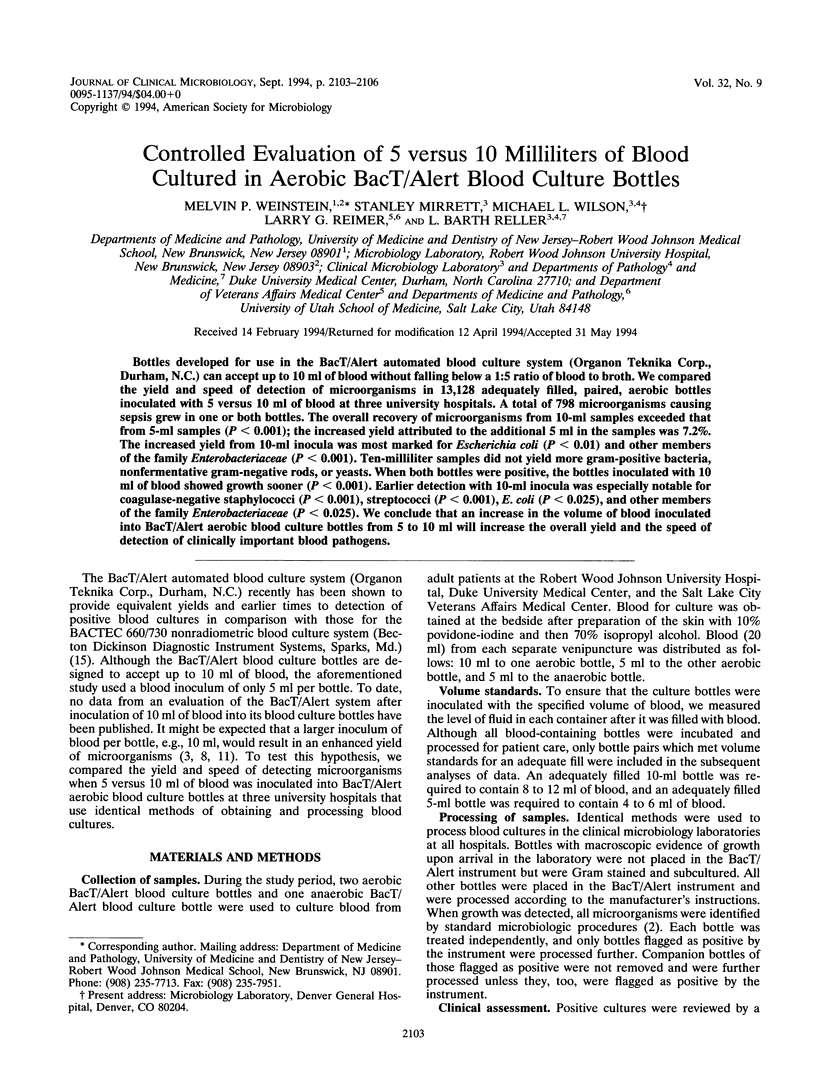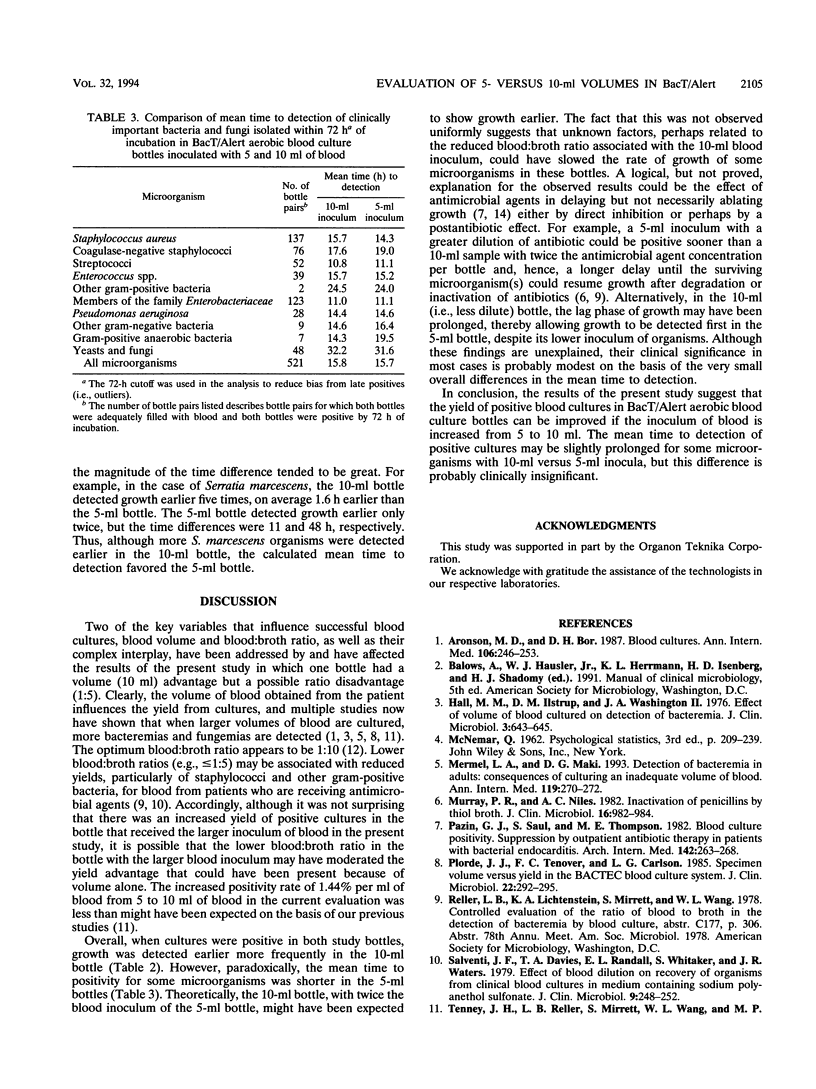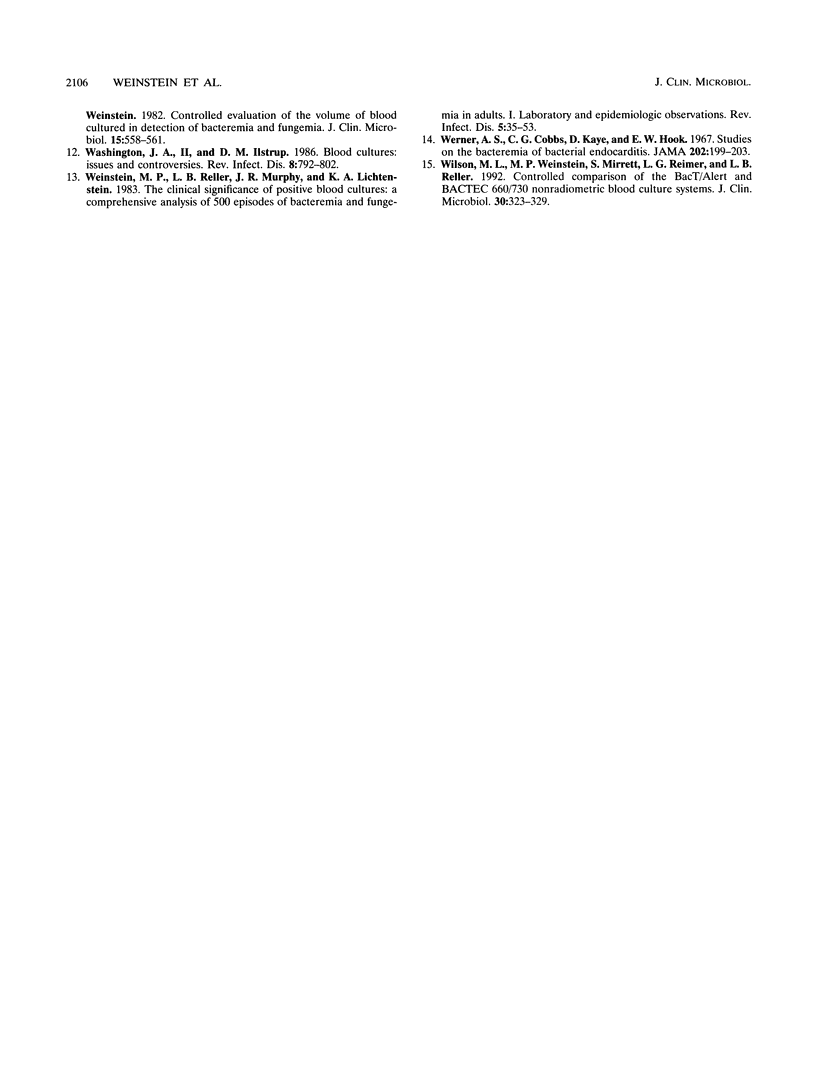Abstract
Bottles developed for use in the BacT/Alert automated blood culture system (Organon Teknika Corp., Durham, N.C.) can accept up to 10 ml of blood without falling below a 1:5 ratio of blood to broth. We compared the yield and speed of detection of microorganisms in 13,128 adequately filled, paired, aerobic bottles inoculated with 5 versus 10 ml of blood at three university hospitals. A total of 798 microorganisms causing sepsis grew in one or both bottles. The overall recovery of microorganisms from 10-ml samples exceeded that from 5-ml samples (P < 0.001); the increased yield attributed to the additional 5 ml in the samples was 7.2%. The increased yield from 10-ml inocula was most marked for Escherichia coli (P < 0.01) and other members of the family Enterobacteriaceae (P < 0.001). Ten-milliliter samples did not yield more gram-positive bacteria, nonfermentative gram-negative rods, or yeasts. When both bottles were positive, the bottles inoculated with 10 ml of blood showed growth sooner (P < 0.001). Earlier detection with 10-ml inocula was especially notable for coagulase-negative staphylococci (P < 0.001), streptococci (P < 0.001), E. coli (P < 0.025), and other members of the family Enterobacteriaceae (P < 0.025). We conclude that an increase in the volume of blood inoculated into BacT/Alert aerobic blood culture bottles from 5 to 10 ml will increase the overall yield and the speed of detection of clinically important blood pathogens.
Full text
PDF



Selected References
These references are in PubMed. This may not be the complete list of references from this article.
- Aronson M. D., Bor D. H. Blood cultures. Ann Intern Med. 1987 Feb;106(2):246–253. doi: 10.7326/0003-4819-106-2-246. [DOI] [PubMed] [Google Scholar]
- Hall M. M., Ilstrup D. M., Washington J. A., 2nd Effect of volume of blood cultured on detection of bacteremia. J Clin Microbiol. 1976 Jun;3(6):643–645. doi: 10.1128/jcm.3.6.643-645.1976. [DOI] [PMC free article] [PubMed] [Google Scholar]
- Mermel L. A., Maki D. G. Detection of bacteremia in adults: consequences of culturing an inadequate volume of blood. Ann Intern Med. 1993 Aug 15;119(4):270–272. doi: 10.7326/0003-4819-119-4-199308150-00003. [DOI] [PubMed] [Google Scholar]
- Murray P. R., Niles A. C. Inactivation of penicillins by Thiol broth. J Clin Microbiol. 1982 Nov;16(5):982–984. doi: 10.1128/jcm.16.5.982-984.1982. [DOI] [PMC free article] [PubMed] [Google Scholar]
- Pazin G. J., Saul S., Thompson M. E. Blood culture positivity: suppression by outpatient antibiotic therapy in patients with bacterial endocarditis. Arch Intern Med. 1982 Feb;142(2):263–268. [PubMed] [Google Scholar]
- Plorde J. J., Tenover F. C., Carlson L. G. Specimen volume versus yield in the BACTEC blood culture system. J Clin Microbiol. 1985 Aug;22(2):292–295. doi: 10.1128/jcm.22.2.292-295.1985. [DOI] [PMC free article] [PubMed] [Google Scholar]
- Salventi J. F., Davies T. A., Randall E. L., Whitaker S., Waters J. R. Effect of blood dilution on recovery of organisms from clinical blood cultures in medium containing sodium polyanethol sulfonate. J Clin Microbiol. 1979 Feb;9(2):248–252. doi: 10.1128/jcm.9.2.248-252.1979. [DOI] [PMC free article] [PubMed] [Google Scholar]
- Tenney J. H., Reller L. B., Mirrett S., Wang W. L., Weinstein M. P. Controlled evaluation of the volume of blood cultured in detection of bacteremia and fungemia. J Clin Microbiol. 1982 Apr;15(4):558–561. doi: 10.1128/jcm.15.4.558-561.1982. [DOI] [PMC free article] [PubMed] [Google Scholar]
- Washington J. A., 2nd, Ilstrup D. M. Blood cultures: issues and controversies. Rev Infect Dis. 1986 Sep-Oct;8(5):792–802. doi: 10.1093/clinids/8.5.792. [DOI] [PubMed] [Google Scholar]
- Weinstein M. P., Reller L. B., Murphy J. R., Lichtenstein K. A. The clinical significance of positive blood cultures: a comprehensive analysis of 500 episodes of bacteremia and fungemia in adults. I. Laboratory and epidemiologic observations. Rev Infect Dis. 1983 Jan-Feb;5(1):35–53. doi: 10.1093/clinids/5.1.35. [DOI] [PubMed] [Google Scholar]
- Werner A. S., Cobbs C. G., Kaye D., Hook E. W. Studies on the bacteremia of bacterial endocarditis. JAMA. 1967 Oct 16;202(3):199–203. [PubMed] [Google Scholar]
- Wilson M. L., Weinstein M. P., Reimer L. G., Mirrett S., Reller L. B. Controlled comparison of the BacT/Alert and BACTEC 660/730 nonradiometric blood culture systems. J Clin Microbiol. 1992 Feb;30(2):323–329. doi: 10.1128/jcm.30.2.323-329.1992. [DOI] [PMC free article] [PubMed] [Google Scholar]


